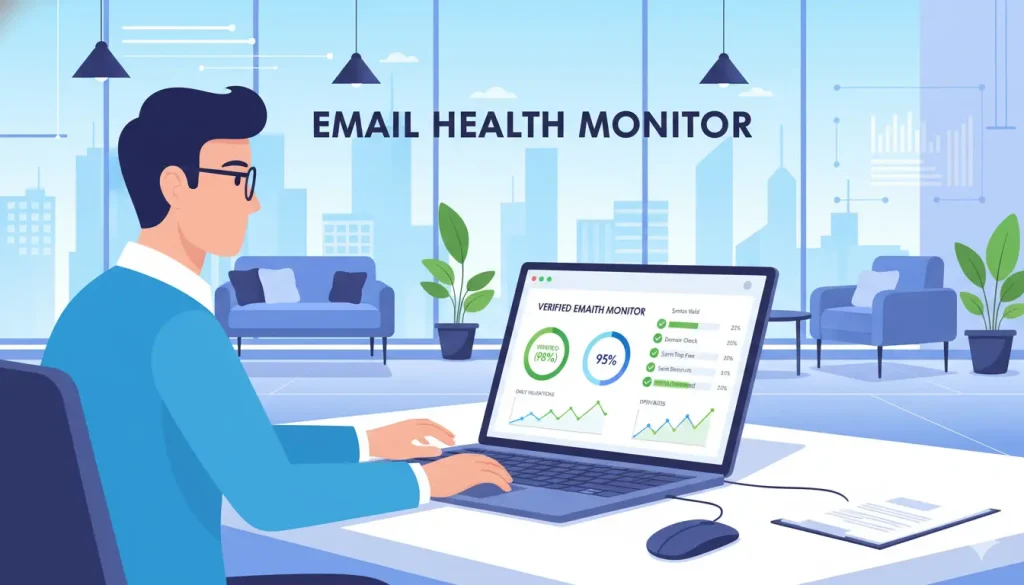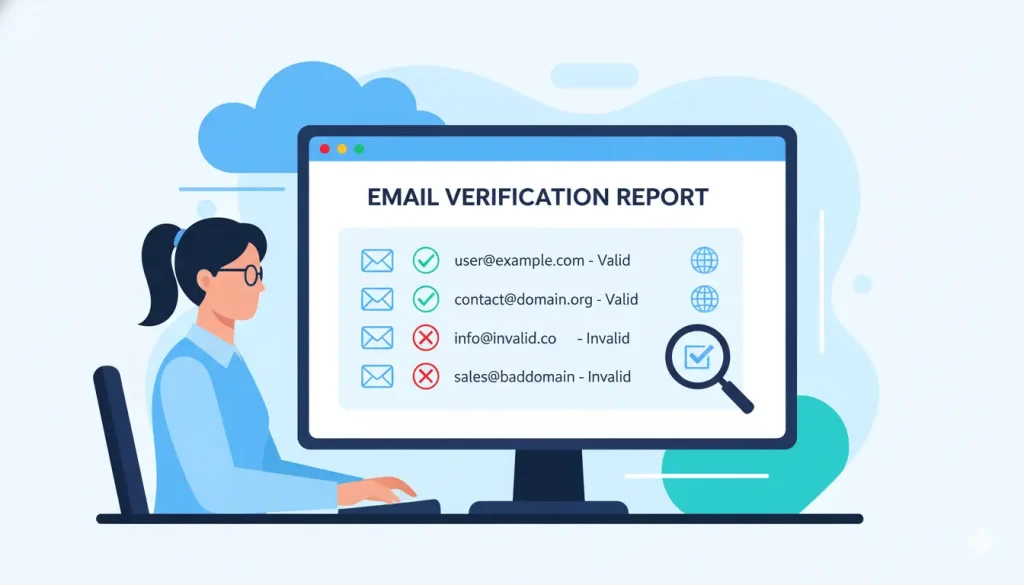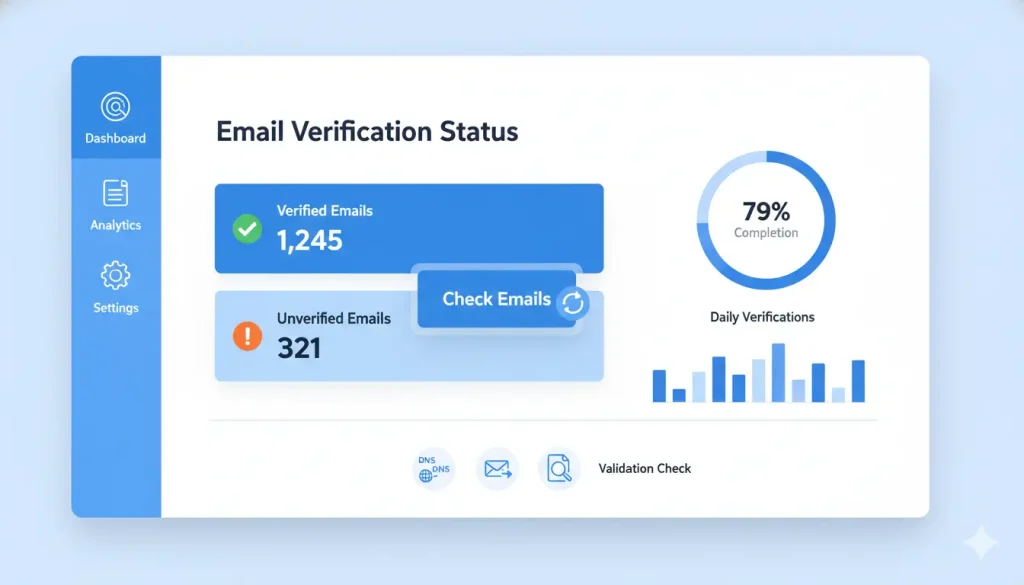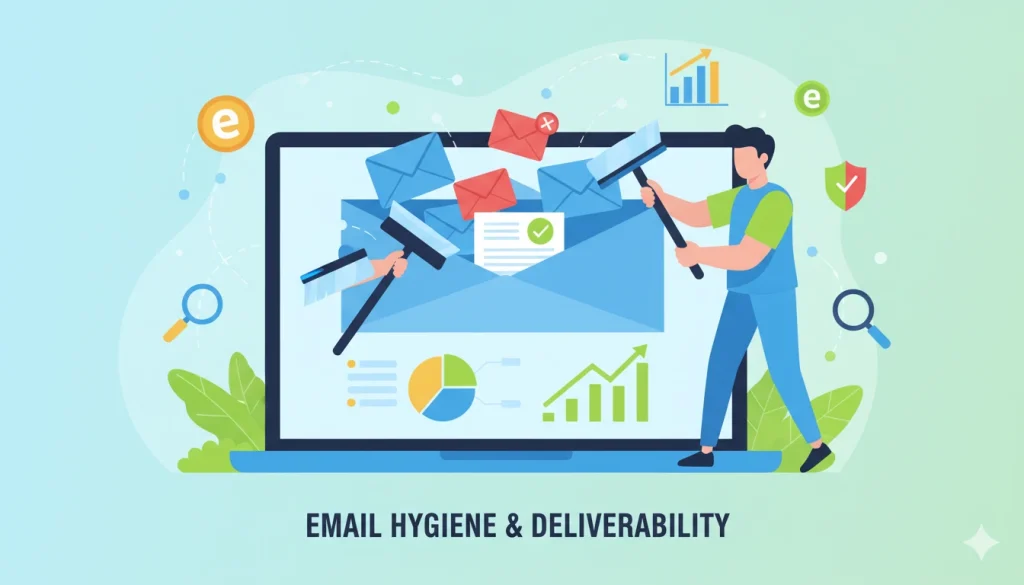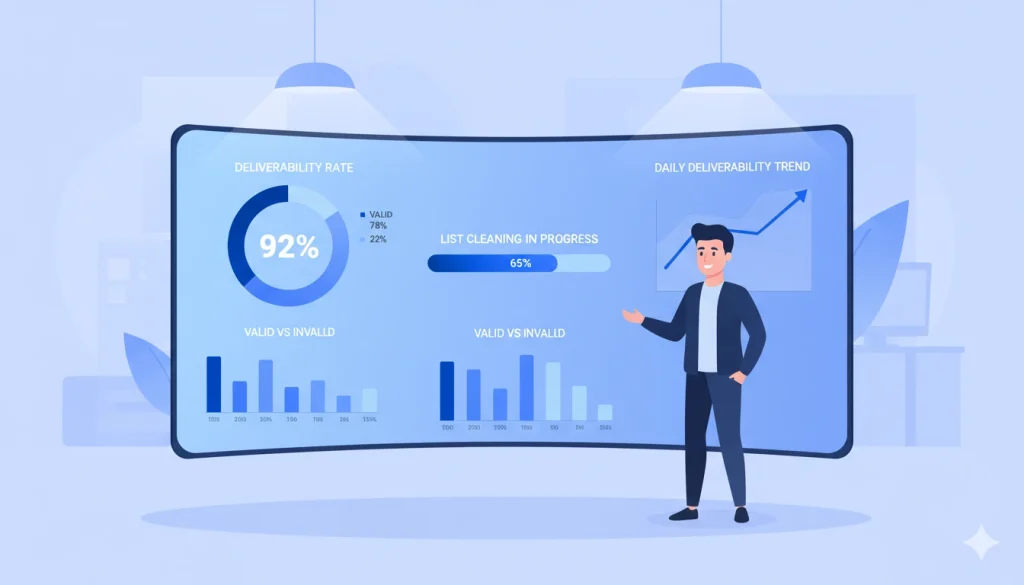If you’ve ever watched a perfectly planned email campaign crash because half your messages bounced, you already know why email verification matters. It’s not about vanity metrics or fancy tools. It’s about protecting your sender reputation, keeping real people on your list, and making sure every message lands where it should.
A good email verification API does that quietly in the background while you focus on growth. It catches typos, filters out junk addresses, and keeps your database clean without slowing your workflow. In this guide, we’ll unpack how to choose, test, and scale a free email verification API that actually delivers.
What An Email Verification API Actually Does
Before you choose a provider, it helps to know what an email verification API really does behind the scenes. It’s not just a “check if this email exists” button. A good one performs several layers of validation to make sure every address you collect is worth keeping.
Syntax, Domain, And Mailbox—What’s Really Being Checked?
It starts with syntax validation to catch obvious typos like “@gmal.com.” Then it checks the domain’s DNS and MX records to confirm that the domain can actually receive mail. Finally, it probes the mailbox to see if that specific inbox is active and accepting messages.
Real-Time Vs. Batch—When To Use Each Without Slowing Teams Down
Real-time verification runs as users type or submit a form, stopping bad data before it enters your system. Batch verification, on the other hand, is perfect for cleaning existing lists before a campaign.
Catch-All, Disposable, And Role-Based—Why These Flags Matter
APIs also detect disposable or role-based addresses, so you can filter risky or low-quality leads that often damage deliverability.
How To Evaluate “Free” Plans Without Getting Burned
Free plans can be a smart way to test an email verification API, but only if you know what to look for. Many providers advertise “unlimited” or “free forever,” yet hide limits that quietly disrupt your workflow when you least expect it.
Hard Limits, Soft Caps, And Overage Gotchas
Always check what “free” really means. Some APIs stop working after a daily or monthly quota. Others throttle performance or block high-volume requests. Knowing these details helps you avoid downtime during critical launches.
Accuracy You Can Trust—Not Just A Marketing Number
Test accuracy on your own sample lists. Don’t just trust the claimed 98% precision. Run side-by-side checks to see how many false positives or missed invalids you get.
Latency, Uptime, And SLAs That Won’t Break Launch Day
Pay attention to response speed and uptime guarantees. A slow API can ruin real-time user experiences.
Data Retention And Vendor Lock-In
Finally, confirm that your data is deleted after use, and you can easily switch providers without losing anything.
Must-Have Technical Features Developers Actually Care About
Once you’ve vetted the basics, it’s time to dig into what really makes a free email verification API worth your time — the technical details. These are the things that make integration smooth and performance stable when your traffic spikes.
Clean Endpoints And Predictable Response Schemas
You shouldn’t need guesswork to understand API responses. Look for structured JSON with clear status categories like “valid,” “invalid,” or “catch-all,” along with a reason and confidence score. This makes automation and reporting far simpler.
Rate Limiting That Plays Nice With Your Traffic Spikes
Good APIs let you scale safely. They use rate limits that adapt under pressure and provide headers showing remaining quota. Avoid APIs that just block calls when you hit the ceiling — graceful throttling matters when you’re growing fast.
Webhooks, Bulk Jobs, And Retry Semantics
Reliable APIs support async workflows and retries without duplicating results. Features like idempotency keys and dead-letter queues keep your processes clean.
SDKs, CLIs, And Postman Collections
You’ll save hours if your provider offers SDKs for common languages or ready-to-import Postman collections. These small touches speed up testing, debugging, and launch time.
Integration Playbooks You Can Steal For Common Use Cases
Let’s move from theory to practice. Once you integrate a strong email validation API, it becomes your quiet ally in maintaining clean, reliable data across your workflows. Here’s how you can use it effectively in real-world scenarios.
Sign-Up Forms Without Friction
When new users sign up, use real-time email verification to catch typos and confirm that an email address exists before saving it. Add a debounce strategy to prevent excessive API calls and client hints for friendly corrections. Always perform a server-side SMTP check to confirm that the domain can accept emails and that you’re reaching the intended recipient.
CRM Hygiene On Autopilot
Schedule nightly batch jobs to verify email addresses already in your system. Automatically flag invalid email addresses and non-existent ones, and remove temporary email addresses or disposable email accounts. This helps your email lists stay accurate and consistent across contacts.
Marketing Automation That Saves Your Sender Reputation
Before sending emails, validate your email addresses again to prevent undeliverable emails and reduce bounce rates. Segment risky emails and exclude spam traps to protect email deliverability.
Product-Led Growth Trials That Attract Humans, Not Bots
Filter out free providers like Gmail, Yahoo, or other free email providers to ensure you’re capturing real users. Progressive profiling helps confirm authenticity without requiring a credit card up front.
Abuse And Fraud Mitigation Without False Positives
Combine email checker results with velocity tracking to spot bulk signups or fraud attempts. Tie this data with device fingerprints and servers to block abuse while keeping legitimate accounts safe.
Deliverability And ROI: Proving It Works Internally
Once you start validating email addresses, you’ll want proof that it’s making a real difference. The best way to show that is by tracking measurable performance indicators that matter to your team.
KPIs That Matter To Stakeholders
Focus on bounce rate, complaint rate, inbox placement, and conversion lift. A drop in bounces means fewer disposable email addresses and stronger sender trust. Improved inbox placement boosts open and click rates—especially for cold email outreach campaigns.
A/B Your Way To Confidence
Set up control and holdout groups to test performance. Keep everything else constant—cadence, timing, and message—and see how valid format and verified data affect results. You can even upload your results to Google Sheets to visualize the difference.
Close The Loop With Feedback Data
Use your email verifier reports and SMTP server logs to check email addresses that failed. Feed these insights back into your system to improve your quality score, handle edge cases, and keep businesses connected without manual cleanup or extra credit card required barriers.
Compliance, Security, And Ethics—Keeping Users’ Trust
As your verification system grows, compliance and security become essential. You’re not just validating emails—you’re handling user data, and that means earning trust through transparency and responsible design.
Consent And Lawful Basis—Yes, Even For Verification
Every email you verify should have a lawful basis. If your process touches EU or UK data, align with GDPR by clarifying legitimate interest or contractual necessity. Always allow users to opt out easily.
Handling Data With Care
Minimize what you store. Hash addresses where possible and ensure all transmissions are encrypted. Keep your storage and backups separate from production data.
Regional Nuances You Shouldn’t Ignore
Different regions have different rules—CAN-SPAM, CASL, GDPR. Respect each user’s jurisdiction to stay compliant.
Vendor Security Checklist
Before trusting any provider, review their certifications, security policies, and incident response plans. A transparent vendor is a trustworthy one.
Build Vs. Buy: Making The Call Like A Pragmatist
Every growing company faces the same question: should we build our own verification system or use an existing one? The answer depends on how you value time, risk, and flexibility.
The Real Cost Model—Not Just Cloud Bills
Building in-house sounds cheaper, but maintaining uptime, handling protocol changes, and debugging false positives often outweigh initial savings.
Maintenance And Risk Surface
Email standards shift. SMTP servers evolve, and spam filters tighten. Each change means more engineering time and new failure points.
When Buying Wins
A proven solution already handles edge cases, performance tuning, and compliance. You gain reliability, insights, and faster time to market—while your engineers focus on what makes your product special.
Your Next Best Step In Under A Week
You now know exactly how to choose, integrate, and scale a reliable email verification system that protects your deliverability and improves ROI. The right API doesn’t just clean your list—it builds a healthier relationship between your brand and your audience.
Start small. Pick one integration—sign-up forms, CRM cleanup, or campaign prep—and measure the impact. Within a week, you’ll see how much smoother your workflows become when verification runs quietly in the background.
And if you want to test-drive a free email verification service, try our trial. No sales pitch, no commitments—just real results.

